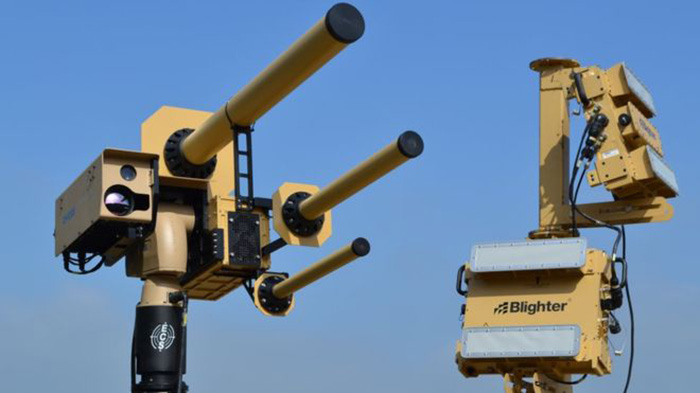After this disruption, the operator is likely to retrieve the drone believing that it has malfunctioned.
The system joins a host of recently announced technologies which can blast larger drones out of the sky.
A drone flying in sensitive airspace can be detected by the Auds radar and then sighted via a camera equipped with thermal imaging capabilities so that it can be targeted visually.
Then, a high-powered radio signal can be focused on the drone - essentially overriding the connection to whoever is operating it.
The whole process takes as little as 25 seconds, according to the manufacturers.
"It`s a radio signal. There are a number of frequency bands that are used by all of the manufacturers," explained Paul Taylor of Enterprise Control Systems, which developed the product along with Blighter Surveillance Systems and Chess Dynamics.
"We transmit into those frequencies in the direction of the UAV using a directional antenna," he told the BBC.
"There`s quite a lot of radio power on to the UAV - so much so that it can only hear our Auds signal."
The Auds operator can then choose to freeze the drone just for a short time - to convince its owner that there`s something wrong with it - or for a longer period, until its battery dies and it crashes.
Auds has been tested in the UK, the USA and France, said Mr Taylor, and government organisations in all three countries had been involved in those tests.
Aviation authorities are increasingly concerned about nuisance hobbyists flying drones close to large aircraft at airports.
The US Federal Aviation Authority (FAA) is now receiving around 100 reports per month from pilots who have sighted drones within a five-mile radius of their aircraft.
Last year the sightings numbered only a few per month.
In response, the FAA recently signed an agreement to test new technology which detects drones and identifies the location of their operator.
A spokesman for UK`s Civil Aviation Authority, however, told the BBC that the organisation was not likely to consider investigating similar technologies any time soon.
"It`s not something that we really feel the need to be doing," he said. "Our focus is on educating consumers.
"We`ve had our rules in place for over six years now.
"The FAA are a little late to the party in many ways - they developed their regulations only recently."
Beyond simply halting a small quadcopter drone while in flight, there are also military grade weapons now available to blast larger UAVs out of the sky.
The US Army recently demonstrated a prototype weapon which fires special projectiles at UAVs to damage them.
These projectiles can be steered on approach to the drone, which is tracked on the ground with radar.
Once close enough, warheads on the projectiles can be detonated, theoretically destroying the target vehicle.
Alternatively, militaries around the world could also soon be swatting UAVs out of the air with lasers thanks to Boeing`s Compact Laser Weapons System.
A recent video published on the company`s YouTube profile shows the weapon in action as it burns through the tail of an airborne drone.
Although the technology might sound futuristic, earlier prototypes of so-called "beam weapons" were being tested as long ago as 1974.
It`s taken decades of development for them to be considered viable weapon systems for the military today.
More about:
















































